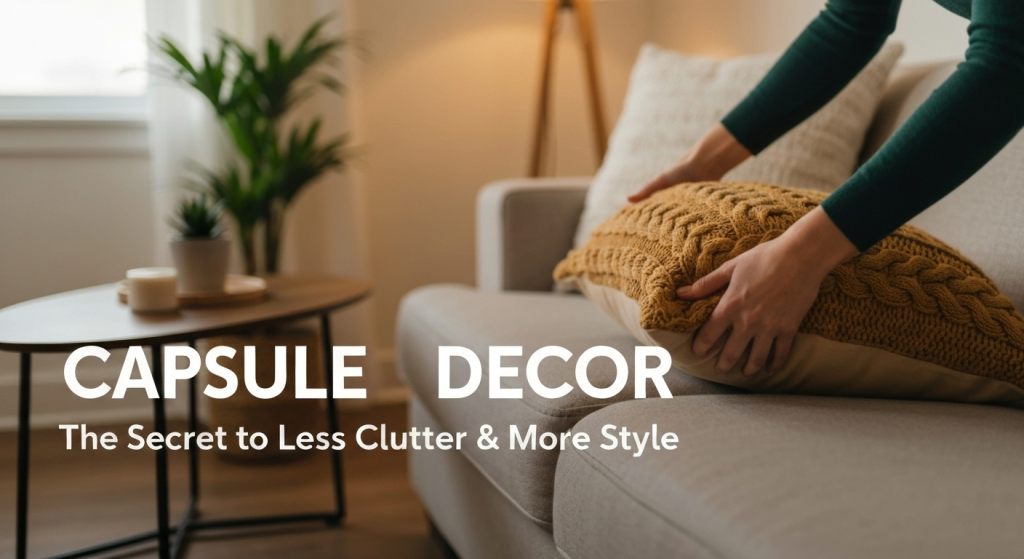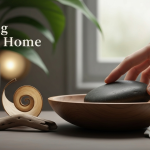Are you tired of looking around your home and feeling… overwhelmed? That constant pressure to buy the latest trend, the piles of decor that don’t quite “go” together, and the feeling that your space is more cluttered than curated can be exhausting. If you’ve ever wished you could simplify your home without sacrificing style, you’re not alone. The solution isn’t about buying more; it’s about being more intentional. Let’s talk about capsule decor, a thoughtful approach that transforms your home into a stylish, serene, and functional sanctuary.
My name is William Johnson, and for years, I’ve been fascinated by the stories our homes tell. My journey into home decor wasn’t about following fleeting trends, but about understanding how to create spaces that genuinely feel good to live in. This curiosity has led me down many paths, from exploring minimalist principles to diving into the psychology of color. Through years of writing and personal experimentation, I’ve learned that the most beautiful homes aren’t the ones with the most stuff, but the ones where every object has a purpose and a place. Sharing these practical, clutter-free strategies is what I enjoy most.
What Exactly Is Capsule Decor?
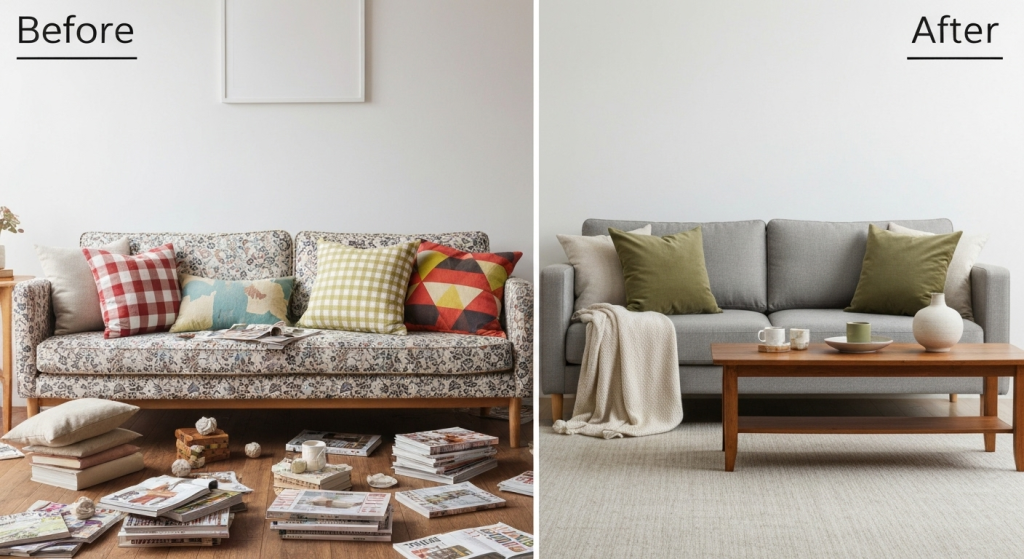
Let’s break it down. You’ve likely heard of a “capsule wardrobe.” It’s the idea of having a small collection of high-quality, versatile clothing items that you can mix and match to create many different outfits. Capsule decor applies this exact same logic to your home.
Instead of filling your rooms with countless trendy items that quickly feel dated, you build a foundation of timeless, high-quality “base” pieces. Think of your sofa, dining table, and bed frame. These are your investment pieces. Then, you layer in a smaller, curated collection of “accent” items—like pillows, throws, and vases—that you can easily rotate to refresh your space. It’s a simple shift from quantity to quality, from clutter to clarity. This method isn’t about restriction; it’s about freedom. The freedom from decision fatigue, from overspending, and from a home that doesn’t truly reflect you.
The Real-World Benefits of a Capsule Approach
Adopting a capsule decor mindset brings more than just a tidy-looking room. It changes your relationship with your home and your belongings. Over the five years I’ve been refining this approach in my own space, the benefits have become incredibly clear.
- Drastically Reduces Clutter: With fewer, more intentional items, your home naturally feels more open and peaceful. Surfaces become clear, and there’s a sense of calm that’s hard to achieve when every corner is filled.
- Saves You Money (Seriously): While you might invest more upfront in a quality sofa or dining table, you stop wasting money on cheap, trendy decor that you’ll discard in a year. Your overall spending on home goods plummets.
- Makes Decorating Effortless: When you want a change, you don’t need to overhaul the entire room. Swapping out a few pillows and a throw blanket can completely change the vibe, making seasonal updates quick, easy, and affordable.
- Creates a Cohesive, Designer Look: Because your foundation pieces are chosen to work together, your home will have a naturally harmonious and polished feel. Everything just works.
- A More Sustainable Choice: By buying fewer, better-quality items that last for years, you reduce waste and your environmental footprint. It’s a more conscious way to consume.
Building Your Foundation: The Core Capsule Pieces
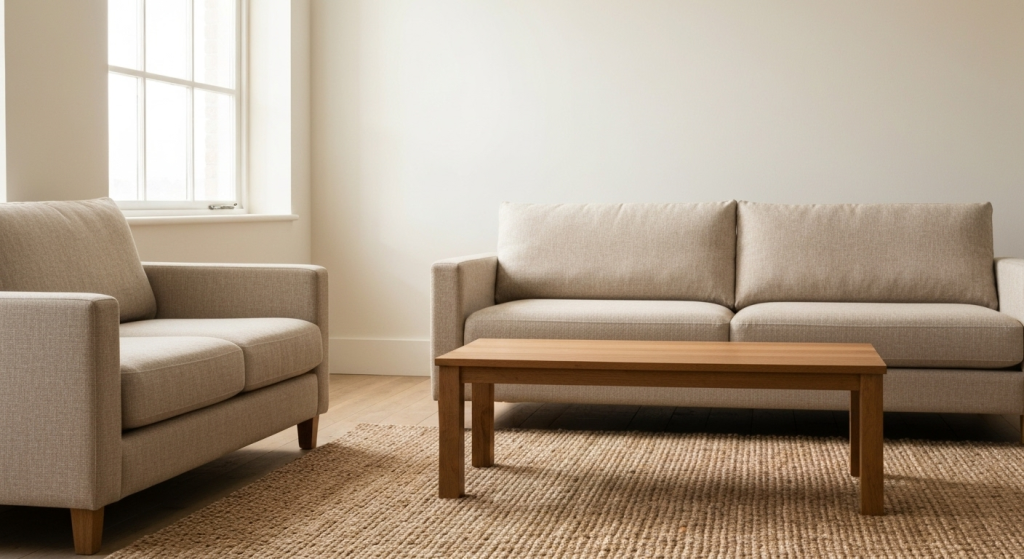
Your core pieces are the workhorses of your home. They are the furniture and fixtures that you use every single day. Choosing them wisely is the most important step in creating a successful capsule interior. The goal here is to select items with timeless appeal, neutral palettes, and durable construction.
What Qualifies as a Core Piece?
Think of the largest, most functional items in each room. These aren’t the small decorative bits; they are the anchors that define the space.
- Living Room: Sofa, armchairs, coffee table, media unit, large area rug.
- Dining Room: Dining table, chairs, sideboard or buffet, primary light fixture.
- Bedroom: Bed frame, nightstands, dresser, a comfortable chair if space allows.
How to Choose Your Foundation
When you’re shopping for these items, filter your choices through three main criteria: versatility, quality, and timelessness.
- Versatility: A simple, clean-lined sofa in a neutral color like gray, beige, or navy will adapt to almost any accent color you throw at it. A classic wooden dining table can feel rustic, modern, or traditional depending on the chairs and centerpiece you pair with it. Avoid bold patterns or overly specific styles for these large items.
- Quality: This is where you should invest your budget. A well-made sofa with a solid wood frame will outlast a cheaper alternative by a decade or more. Look for solid wood construction, durable fabrics, and reputable brands. A mistake I made early on was buying a cheap, stylish rug that shed constantly and looked worn within a year. Investing in a quality wool rug later saved me frustration and money in the long run.
- Timelessness: Ask yourself, “Will I still love this in ten years?” Designs with simple silhouettes, like a classic Lawson-style sofa or a Parsons dining table, have remained popular for a reason—they don’t go out of style.
Here’s a quick comparison of common materials for a foundation piece like a coffee table:
| Material | Pros | Cons | Best For |
| Solid Wood | Extremely durable, can be refinished, develops character over time. | Can be expensive, susceptible to scratches and water rings. | Creating a warm, timeless, and natural feel. |
| Metal | Very strong, sleek, and modern aesthetic. Easy to clean. | Can feel cold or industrial, may show fingerprints. | Modern, minimalist, or industrial styles. |
| Glass | Creates a sense of openness and light, doesn’t add visual weight. | Shows smudges and dust easily, can chip or break. | Small spaces where you want to maintain an airy feel. |
| Marble/Stone | Elegant and luxurious, very durable. | Heavy, porous (can stain), often a higher price point. | Adding a touch of sophistication and classic style. |
Choosing neutral, high-quality foundation pieces gives you a perfect blank canvas. Now for the fun part: adding personality.
The Rotational Accents: Your Decor ‘Wardrobe’
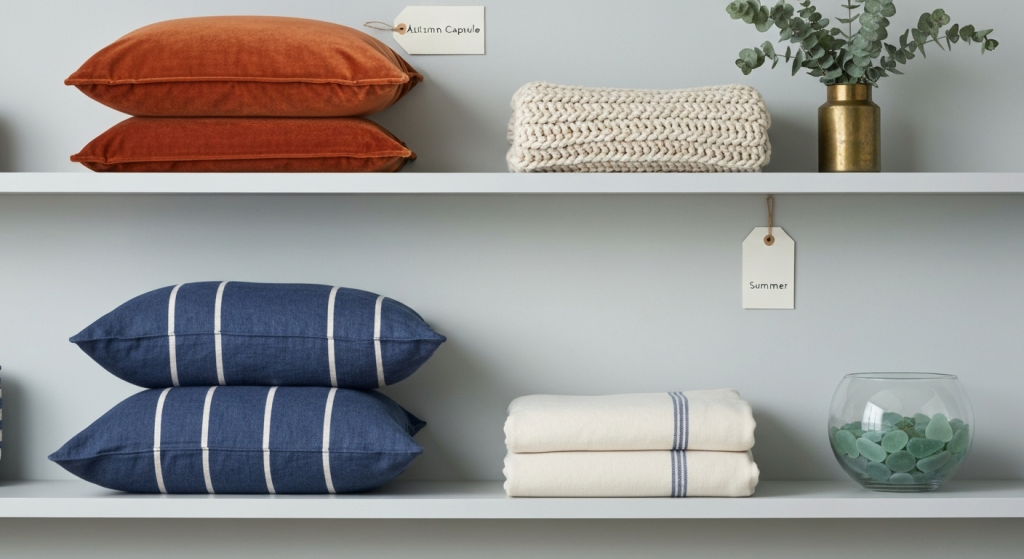
This is where your personal style truly gets to shine. Your accent capsules are small, curated collections of decorative items that you can swap in and out to match the season, a holiday, or even just your mood. They are the low-commitment, high-impact elements of your home.
What Are Accent Pieces?
Think of anything that adds color, texture, and personality to a room without being a major piece of furniture.
- Textiles: Throw pillows, blankets, curtains, table runners, and cloth napkins.
- Decorative Objects: Vases, bowls, trays, candles, and sculptures.
- Art: Small framed prints or posters that can be easily swapped.
- Greenery: Small potted plants or arrangements of seasonal branches or flowers.
Curating Your Accent Capsules
The key is to think in collections. Instead of buying one random pillow here and one vase there, group items that work together to create a specific feel. A great way to start is by creating capsules for the four seasons.
Example: A Four-Seasons Accent Capsule Plan
| Capsule | Color Palette | Textures | Example Items |
| Spring | Soft pastels (blush, mint), cream, light gray. | Linen, light cotton, smooth ceramics. | Linen pillow covers, a light cotton throw, a vase with fresh tulips. |
| Summer | Bright whites, navy blue, sunny yellow, coral. | Woven materials (rattan, jute), sheer fabrics. | Striped pillows, a lightweight throw, a bowl of seashells or lemons. |
| Autumn | Warm earth tones (rust, mustard, olive green). | Wool, chunky knit, velvet, raw wood. | Velvet pillow covers, a cozy knit blanket, a display of small pumpkins. |
| Winter | Deep jewel tones (emerald, burgundy), silver/gold. | Faux fur, flannel, metallic finishes. | Faux fur pillows, a plaid flannel throw, mercury glass candle holders. |
The Storage Solution
“But where do I store all these rotating items?” This is a valid concern. The goal is not to trade furniture clutter for closet clutter.
- Use Clear Bins: Store each “capsule” in a dedicated, labeled bin. This makes finding your autumn decor in September a breeze.
- Think Vertically: Utilize shelf space in closets, the garage, or the basement.
- Under-the-Bed Storage: Flat, rolling containers are perfect for storing textiles like pillow covers and throws.
- One In, One Out: If you buy a new accent piece, consider letting go of one you no longer love. This keeps your collections manageable.
A Step-by-Step Guide to Creating Your Capsule Home
Ready to get started? Here’s a practical, step-by-step process to transition your home to a capsule model.
Step 1: Declutter and Assess Your Current Decor
This is the most crucial first step. You can’t build an intentional space on a foundation of clutter. Go through your home room by room and be honest.
- Keep What You Love: Identify the pieces that bring you joy or have sentimental value. These are the keepers.
- Identify Your Foundation: Look at your big furniture. Is your sofa neutral and in good shape? Is your dining table a classic? These may already be your core pieces.
- Sort the Rest: For everything else, ask: “Do I love it? Do I use it? Does it fit the vision for my home?” If the answer is no, it’s time to donate, sell, or discard it.
Step 2: Define Your Core Style and Color Palette
Before you buy anything new, you need a plan. What is the overall feeling you want in your home?
- Find Your Style: Are you drawn to Scandinavian minimalism, cozy modern farmhouse, or eclectic bohemian? Create a Pinterest board or save images of rooms you love to find common themes.
- Choose a Base Palette: Select 3-4 neutral colors that will dominate your foundational pieces. A common and effective palette is:
- A primary white or off-white.
- A secondary light neutral like beige or light gray.
- A darker accent neutral like charcoal, navy, or black.
- A natural tone from wood or leather.
Step 3: Invest in Your Foundational Pieces
Slowly and thoughtfully acquire or recommit to your core items. This doesn’t have to happen all at once. Prioritize the piece that will make the biggest impact, like a new sofa for the living room. Remember the criteria: versatile, high-quality, and timeless.
Step 4: Curate and Build Your Accent Capsules
This is where your personality comes into play. Start with one seasonal capsule. For example, if it’s autumn, gather or purchase a few items in a warm color palette.
- Start small. You only need 3-5 accent items per room to make a big impact. A couple of pillows, a throw, and a new centerpiece are often enough.
- Shop your own home first! You might have a vase tucked away in a cabinet that’s perfect for your new capsule.
Capsule Decor in Action: Room-by-Room Ideas
Let’s see how this works in practice.
The Living Room
The living room is often the heart of the home, making it a perfect place to start.
- Foundation: A comfortable, neutral gray sectional sofa, a solid oak coffee table, and a large jute rug.
- Autumn Accent Capsule: Swap in pillows in rust and olive green velvet, add a chunky cream-colored knit throw, and place a wooden bowl with pinecones on the coffee table.
- Spring Accent Capsule: Replace the pillows with light blue and blush linen covers, switch to a lightweight cotton blanket, and fill a ceramic vase with fresh flowers.
- What this means: The entire feel of the room changes, but the expensive, core pieces remain the same. The transformation is quick, affordable, and easy to reverse.
The Bedroom
Your bedroom should be a sanctuary. A capsule approach keeps it serene and uncluttered.
- Foundation: A simple wooden or upholstered bed frame, matching nightstands, and a neutral-colored duvet cover.
- Winter Accent Capsule: Layer a faux fur throw blanket at the foot of the bed, add two deep emerald green accent pillows, and place silver-framed art on the nightstand.
- Summer Accent Capsule: Switch to a lightweight linen quilt, use crisp white accent pillows, and place a small potted fern on the dresser. The room instantly feels lighter and airier.
Common Mistakes to Avoid
Transitioning to capsule decor is a journey, and there can be a few bumps along the way. Here are some common pitfalls and how to steer clear of them.
- Going Too Trendy on Core Pieces: That bright teal sofa might seem amazing now, but it will severely limit your accent color choices and may look dated in a few years. The fix: Save the bold trends for your inexpensive accent pieces.
- Creating Clutter with Your Capsules: The point is to have fewer things, not just different things. Owning 50 throw pillows, even if they’re organized by season, defeats the purpose. The fix: Set a limit. For example, decide you’ll only have 5-7 throw pillows in rotation for the entire house at any given time.
- Forgetting About Texture: A room with all smooth surfaces can feel flat and sterile, even if the colors are right. The fix: Make sure each accent capsule includes a variety of textures—a chunky knit, a smooth ceramic, a rough-hewn wood, a soft velvet. This adds depth and interest.
Frequently Asked Questions
How many items should be in a capsule decor collection?
There’s no magic number. It’s about what feels right for your space. A good starting point is to have 10-15 core foundational pieces for your whole home and 5-10 rotating accent items per room for each “capsule” you create (e.g., for each season).
Is capsule decor only for minimalists?
Not at all! While it shares principles with minimalism (like intentionality and less clutter), you can apply it to any style. A bohemian capsule home would have a foundation of natural wood and rattan, with rotating accents of macrame, colorful textiles, and lots of plants.
How often should I rotate my accents?
Many people find that rotating seasonally works best—about four times a year. However, there are no rules. You could do a small refresh for a specific holiday or just whenever you feel like you need a change.
What if I live with a partner or family with a different style?
This is a great opportunity for compromise. Agree on neutral, classic foundation pieces together. Then, allow each person to influence the accent capsules. Perhaps one season’s accents reflect one person’s taste more, and the next reflects the other’s.
Conclusion: More Style, Less Stress
Adopting the capsule decor concept is more than a decorating strategy; it’s a mindset shift. It’s about choosing intention over impulse and creating a home that supports you rather than overwhelms you. By building a solid foundation of pieces you love and rotating in accents that bring you joy, you can create a beautiful, functional, and deeply personal space. You’ll free yourself from the endless cycle of trends, save money, and finally have a home that feels both stylish and serene. It’s time to embrace less, and enjoy your home more.
